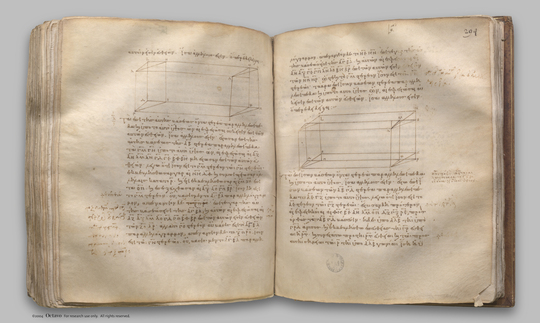index prev next | digilib folio 298

Parallelepipedal solids which are on the same base and of the same height, and in which the extremities of the sides which stand up are not on the same straight lines, are equal to one another.
| Τὰ ἐπὶ τῆς αὐτῆς βάσεως ὄντα στερεὰ παραλληλεπίπεδα καὶ ὑπὸ τὸ αὐτὸ ὕψος, ὧν αἱ ἐφεστῶσαι οὐκ εἰσὶν ἐπὶ τῶν αὐτῶν εὐθειῶν, ἴσα ἀλλήλοις ἐστίν. Ἔστω ἐπὶ τῆς αὐτῆς βάσεως τῆς ΑΒ στερεὰ παραλληλεπίπεδα τὰ ΓΜ, ΓΝ ὑπὸ τὸ αὐτὸ ὕψος, ὧν αἱ ἐφεστῶσαι αἱ ΑΖ, ΑΗ, ΛΜ, ΛΝ, ΓΔ, ΓΕ, ΒΘ, ΒΚ μὴ ἔστωσαν ἐπὶ τῶν αὐτῶν εὐθειῶν: λέγω, ὅτι ἴσον ἐστὶ τὸ ΓΜ στερεὸν τῷ ΓΝ στερεῷ. Ἐκβεβλήσθωσαν γὰρ αἱ ΝΚ, ΔΘ καὶ συμπιπτέτωσαν ἀλλήλαις κατὰ τὸ Ρ, καὶ ἔτι ἐκβεβλήσθωσαν αἱ ΖΜ, ΗΕ ἐπὶ τὰ Ο, Π, καὶ ἐπεζεύχθωσαν αἱ ΑΞ, ΛΟ, ΓΠ, ΒΡ. ἴσον δή ἐστι τὸ ΓΜ στερεόν, οὗ βάσις μὲν τὸ ΑΓΒΛ παραλληλόγραμμον, ἀπεναντίον δὲ τὸ ΖΔΘΜ, τῷ ΓΟ στερεῷ, οὗ βάσις μὲν τὸ ΑΓΒΛ παραλληλόγραμμον, ἀπεναντίον δὲ τὸ ΞΠΡΟ: ἐπί τε γὰρ τῆς αὐτῆς βάσεώς εἰσι τῆς ΑΓΒΛ καὶ ὑπὸ τὸ αὐτὸ ὕψος, ὧν αἱ ἐφεστῶσαι αἱ ΑΖ, ΑΞ, ΛΜ, ΛΟ, ΓΔ, ΓΠ, ΒΘ, ΒΡ ἐπὶ τῶν αὐτῶν εἰσιν εὐθειῶν τῶν ΖΟ, ΔΡ. ἀλλὰ τὸ ΓΟ στερεόν, οὗ βάσις μέν ἐστι τὸ ΑΓΒΛ παραλληλόγραμμον, ἀπεναντίον δὲ τὸ ΞΠΡΟ, ἴσον ἐστὶ τῷ ΓΝ στερεῷ, οὗ βάσις μὲν τὸ ΑΓΒΛ παραλληλόγραμμον, ἀπεναντίον δὲ τὸ ΗΕΚΝ: ἐπί τε γὰρ πάλιν τῆς αὐτῆς βάσεώς εἰσι τῆς ΑΓΒΛ καὶ ὑπὸ τὸ αὐτὸ ὕψος, ὧν αἱ ἐφεστῶσαι αἱ ΑΗ, ΑΞ, ΓΕ, ΓΠ, ΛΝ, ΛΟ, ΒΚ, ΒΡ ἐπὶ τῶν αὐτῶν εἰσιν εὐθειῶν τῶν ΗΠ, ΝΡ. ὥστε καὶ τὸ ΓΜ στερεὸν ἴσον ἐστὶ τῷ ΓΝ στερεῷ. Τὰ ἄρα ἐπὶ τῆς αὐτῆς βάσεως στερεὰ παραλληλεπίπεδα καὶ ὑπὸ τὸ αὐτὸ ὕψος, ὧν αἱ ἐφεστῶσαι οὐκ εἰσὶν ἐπὶ τῶν αὐτῶν εὐθειῶν, ἴσα ἀλλήλοις ἐστίν: ὅπερ ἔδει δεῖξαι. | Parallelepipedal solids which are on the same base and of the same height, and in which the extremities of the sides which stand up are not on the same straight lines, are equal to one another. Let CM, CN be parallelepipedal solids on the same base AB and of the same height, and let the extremities of their sides which stand up, namely AF, AG, LM, LN, CD, CE, BH, BK, not be on the same straight lines; I say that the solid CM is equal to the solid CN. For let NK, DH be produced and meet one another at R, and further let FM, GE be produced to P, Q; let AO, LP, CQ, BR be joined. Then the solid CM, of which the parallelogram ACBL is the base, and FDHM its opposite, is equal to the solid CP, of which the parallelogram ACBL is the base, and OQRP its opposite; for they are on the same base ACBL and of the same height, and the extremities of their sides which stand up, namely AF, AO, LM, LP, CD, CQ, BH, BR, are on the same straight lines FP, DR. [XI. 29] But the solid CP, of which the parallelogram ACBL is the base, and OQRP its opposite, is equal to the solid CN, of which the parallelogram ACBL is the base and GEKN its opposite; for they are again on the same base ACBL and of the same height, and the extremities of their sides which stand up, namely AG, AO, CE, CQ, LN, LP, BK, BR, are on the same straight lines GQ, NR. Hence the solid CM is also equal to the solid CN. |